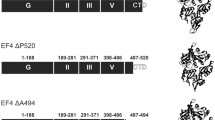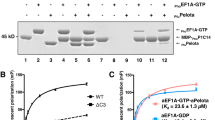Abstract
The G domain and domain II in the crystal structure of Thermus thermophilus elongation factor G (EF-G) were compared with the homologous domains in Thermus aquaticus elongation factor Tu (EF-Tu). Sequence alignment derived from the structural superposition was used to define conserved sequence elements in domain II. These elements and previously known conserved sequence elements in the G domain were used to guide the alignment of the sequences of Sulfolobus acidocaldarius elongation factor 2, human elongation factor 2, and Escherichia coli initiation factor 2 and release factor 3 to the aligned sequences of EF-G and EF-Tu. This alignment, which deviates from previously published alignments, has evolutionary implications and leads to alternative interpretations of biochemical data concerning the interaction of elongation factors with the α-sarcin/ricin region of the ribosome. A single conserved sequence motif in domain II was identified and used to further characterize the GTPase subfamily of translation factors and related proteins. It was shown that the motif is found in most if not all the members of the family. Apparently, the common characteristic of these GTPases is an extensive consensus structural unit that possibly accounts for a similar interaction with the ribosome and is composed of two domains homologous to the G domain and domain II in EF-Tu and EF-G.
Similar content being viewed by others
References
Ævarsson A, Brazhnikov E, Garber M, Zheltonosova J, Chirgadze Y, Alkaradaghi S, Svensson LA, Liljas A (1994) Three-dimensional structure of the ribosomal translocase: elongation factor G from Thermus thermophilus. EMBO J 13:3669–3677
Ann DK, Moutsatsos IK, Nakamura T, Lin HH, Mao P-L, Lee M-J, Chin S, Liem RKH, Wang E (1991) Isolation and characterization of the rat chromosomal gene for a polypeptide (pS1) antigenitally related to statin. J Biol Chem 266:10429–10437
Attwood TK, Beck ME (1994) PRINTS—a protein motif fingerprint database. Protein Eng 7:841–848
Bairoch A, Boeckmann B (1993) The SWISS-PROT protein data bank, recent developments. Nucleic Acids Res 21:3093–3096
Barton GJ, Sternberg MJE (1987) Evaluation and improvement in the automatic alignment of protein sequences. Protein Eng 1:89–94
Berchtold H, Reshetnikova L, Reiser COA, Schirmer NK, Sprinzl M, Hilgenfeld R (1993) Crystal structure of active elongation factor Tu reveals major domain rearrangements. Nature 365:126–132
Bourne HR, Sanders DA, McCormick F (1990) The GTPase superfamily: a conserved switch for diverse cell functions. Nature 348:125–132
Bourne HR, Sanders DA, McCormick F (1991) The GTPase superfamily: conserved structure and molecular mechanism. Nature 349: 117–127
Brünger AT, Milburn MV, Tong L, deVos AM, Jancarik J, Yamaizumi Z, Nishimura S, Ohtsuka E, Kim S-H (1990) Crystal structure of an active form of RAS protein, a complex of a GTP analog and the HRAS p21 catalytic domain. Proc Natl Acad Sci USA 87:4849–4853
Burdett V (1991) Purification and characterization of Tet(M), a protein that renders ribosomes resistant to tetracycline. J Biol Chem 266: 2872–2877
Cammarano P, Palm P, Creti R, Ceccarelli E, Sanangelantoni AM, Tiboni O (1992) Early evolutionary relationships among known life forms inferred from elongation factor EF-2/EF-G sequences—phylogenetic coherence and structure of the archaeal domain. J Mol Evol 34:396–405
Cervantes E, Sharma SB, Maillet F, Vasse J, Truchet G, Rosenberg C (1989) The Rhizobium meliloti host range nodQ gene encodes a protein which shares homology with translation elongation and initiation factors. Mol Microbiol 3:745–755
Creti R, Ceccarelli E, Bocchetta M, Sanangelantoni AM, Tiboni O, Palm P, Cammarano P (1994) Evolution of translational elongation factor (EF) sequences—reliability of global phylogenies inferred from EF-1 α(Tu) and EF-2(G) proteins. Proc Natl Acad Sci USA 91:3255–3259
Czworkowski J, Wang J, Steitz TA, Moore PB (1994) The crystal structure of elongation factor G complexed with GDP, at 2.7 angstrom resolution. EMBO J 13:3661–3668
Dever TE, Glynias ML Merrick WC (1987) GTP-binding domain: three consensus sequence elements with distinct spacing. Proc Natl Acad Sci USA 84:1814–1818
Deveraux J, Haeberli P, Smithies O (1984) A comprehensive set of sequence analysis program for the VAX. Nucleic Acids Res 12: 387–395
Forchhammer K, Leinfelder W, Bock A (1989) Identification of a novel translation factor necessary for the incorporation of selenocysteine into protein. Nature 342:453–456
Genetic Computer Group Inc (1994) Program manual for the Wisconsin package, version 8, September 1994. Genetic Computer Group, 575 Science drive, Madison, WI 53711
Grentzmann G, Brechemierbaey D, Heurgue V, Mora L, Buckingham RH (1994) Localization and characterization of the gene encoding release factor RF3 in Escherichia coli. Proc Natl Acad Sci USA 91:5848–5852
Gribskov M, Mclachlan AD, Eisenberg D (1987) Profile analysis: detection of distantly related proteins. Proc Natl Acad Sci USA 84: 4355–4358
Guillot D, Lavergne JP, Reboud JP (1993) Trp(221) is involved in the protective effect of elongation factor eEF-2 on the ricin/α-sarcin site of the ribosome. J Biol Chem 268:26082–26084
Hoshino S, Miyazawa H, Enomoto T, Hanaoka F, Kikuchi Y, Kikuchi A, Ui M (1989) A human homologue of the yeast GST1 gene codes for a GTP-binding protein and is expressed in a proliferation-dependent manner in mammalian cells. EMBO J 8:3807–3814
Iwabe N, Kuma K-I, Hasegawa M, Osawa S, Miyata T (1989) Evolutionary relationship of archaebacteria, eubacteria, and eucaryotes inferred from phylogenetic trees of duplicated genes. Proc Natl Acad Sci USA 86:9355–9359
Jones TA, Zou J-Y, Cowan SW, Kjeldgaard M (1991) Improved methods for building protein models in electron density maps and the location of errors in these models. Acta Crystallogr A 47:110–119
Jurnak F (1994) The ABC of EF-G. Structure 2:785–788
Kabsch W, Sander C (1983) Dictionary of protein secondary structure: pattern recognition of hydrogen-bonded and geometrical features. Biopolymers 22:2577–2637
Kaziro Y (1978) The role of guanosine 5′-triphosphate in polypeptide chain elongation. Biochim Biophys Acta 505:95–127
Kjeldgaard M Nyborg J (1992) Refined structure of elongation factor EF-Tu from Escherichia coli. J Mol Biol 223:721–742
Kjeldgaard M, Nissen P, Thirup S, Nyborg J (1993) The crystal structure of elongation factor EF-Tu from Thermus aquaticus in the GTP conformation. Structure 1:35–50
Kraulis PJ (1991) MOLSCRIPT: a program to produce both detailed and schematic plots of protein structures. J Appl Crystallogr 24: 946–950
Kushnirov VV, Ter-Avanesyan MD, Telckov MV, Surguchov AP, Smirnov VN, Inge-Vechtomov SG (1988) Nucleotide sequence of the SUP2 (SUP35) gene of Saccharomyces cerevisiae. Gene 66: 45–54
Lambright DG, Noel JP, Hamm HE, Sigler PB (1994) Structural determinants for activation of the α-subunit of a heterotrimeric G protein. Nature 369:621–628
Lechner K, Heller G, Böck A (1988) Gene for the diphteria toxin-susceptible elongation factor 2 from Methanococcus vannielii. Nucleic Acids Res 16:7817–7826
Leyh TS, Vogt TF, Suo Y (1992) The DNA sequence of the sulfate activation locus from Escherichia coli K-12. J Biol Chem 267: 10405–10410
Liljas A, Thirup S, Matheson AT (1986) Evolutionary aspects of ribosome-factor interactions. Chemica Scripta 26B:109–119
March PE, Inouye M (1985) GTP-binding membrane protein of Escherichia coli with sequence homology to initiation factor 2 and elongation factors Tu and G. Proc Natl Acad Sci USA 82:7500–7504
Mikuni O, Ito K, Moffat J, Matsumura K, McCaughan K, Nobukuni T, Tate W, Nakamura Y (1994) Identification of the prfC gene, which encodes peptide-chain-release factor of Escherichia coli. Proc Natl Acad Sci USA 91:5798–5802
Milburn MV, Tong L, de Vos AM, Brunger A, Yamaizumi Z, Nishimura S, Kim S-H (1990) Molecular switch for signal transduction: structural differences between active and inactive forms of protooncogenic ras proteins. Science 247:939–945
Needleman SB, Wunsch CD (1970) A general method applicable to the search for similarities in the amino acid sequence of two proteins. J Mol Biol 48:443–453
Noel JP, Hamm HE, Sigler PB (1993) The 2.2 Å crystal structure of transducin-α complexed with GTPγS. Nature 366:654–662
Ogiwara A, Uchiyama I, Seto Y, Kanehisa M (1992) Construction of a dictionary of sequence motifs that characterize groups of related proteins. Protein Eng 5:479–488
PaiEF, Kabsch W, Krengel U, Holmes KC, John J. Wittinghofer (1989) Structure of the guanine-nucleotide-binding domain of the Ha-ras oncogene product p21 in the triphosphate conformation. Nature 341:209–214
Peter ME, Schirmer NK, Reiser COA, Sprinzl M (1990) Mapping the effector region in Thermus thermophilus elongation factor Tu. Biochemistry 29:2876–2884
Plunkett GIII, Burland V, Daniels DL, Blattner FR (1993) Analysis of the Escherichia coli genome. III. DNA sequence of the region from 87.2 to 89.2 minutes. Nucleic Acids Res 21:3391–3398
Rapp G, Klaudiny J, Hagendorff G, Luck MR, Scheit KH (1989) Complete sequence of the coding region of human elongation factor 2 (EF-2) by enzymatic amplification of cDNA from human ovarian granulosa cells. Biol Chem Hoppe Seyler 370:1071–1075
Sacerdot C, Dessen P, Hershey JW, Plumbridge JA, Grunberg-Manago M (1984) Sequence of the initiation factor IF2 gene: unusual protein features and homologies with elongation factors. Proc Natl Acad Sci USA 81:7787–7791
Sanchez-Peschador R, Brown JT, Roberts M, Urdea M (1988) Homology of the TetM with translational factors: implications for potential modes of tetM conferred tetracyclin resistance. Nucleic Acids Res 16:1218
Saqi MAS, Sternberg MJE (1994) Identification of sequence motifs from a set of proteins with related function. Protein Eng 7:165–171
Schröder J, Klink F (1991) Gene for the ADP-ribosylatable elongation factor 2 from the extreme thermoacidophilic archaebacterium Sulfolobus acidocaldarius—cloning, sequencing, comparative analysis. Eur J Biochem 195:321–327
Smith TF, Waterman MS (1981) Identification of common molecular subsequences. J Mol Biol 147:195–197
Szewczak AA, Moore PB, Chan YL, Wool IG (1993) The conformation of the sarcin/ricin loop from 28S ribosomal RNA. Proc Natl Acad Sci USA 90:9581–9585
Tubulekas I, Hughes D (1993) A single amino acid substitution in elongation factor-Tu disrupts interaction between the ternary complex and the ribosome. J Bacteriol 175:240–250
Vingron M, Waterman MS (1994) Sequence alignment and penalty choice-review of concepts, case studies and implications. J Mol Biol 235:1–12
Voss RH, Hartmann RK, Lippmann C, Alexander C, Jahn O, Erdmann VA (1992) Sequence of the tufA gene encoding elongation factor EF-Tu from Thermus aquaticus and overproduction of the protein in Escherichia coli. Eur J Biochem 207:839–846
Wool IG, Gluck A, Endo Y (1992) Ribotoxin recognition of ribosomal RNA and a proposal for the mechanism of translocation. Trends Biochem Sci 17:266–269
Yakhnin AV, Vorozheykina DP, Matvienko NI (1989) Nucleotide sequence of the Thermus thermophilus HB8 gene coding for elongation factor G. Nucleic Acids Res 17:8863
Author information
Authors and Affiliations
Rights and permissions
About this article
Cite this article
Ævarsson, A. Structure-based sequence alignment of elongation factors Tu and G with related GTPases involved in translation. J Mol Evol 41, 1096–1104 (1995). https://doi.org/10.1007/BF00173191
Received:
Accepted:
Issue Date:
DOI: https://doi.org/10.1007/BF00173191




